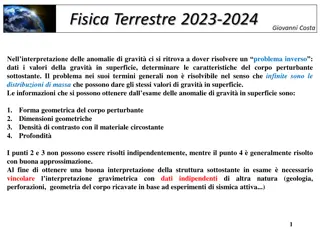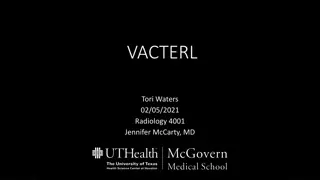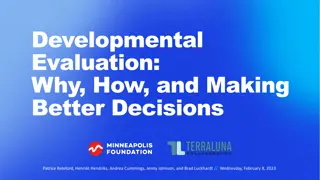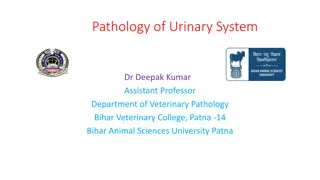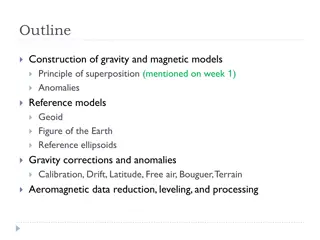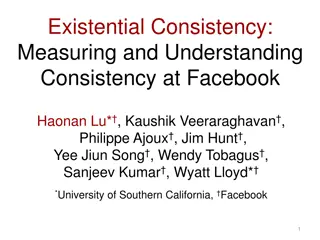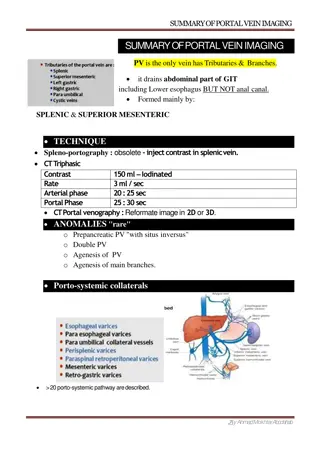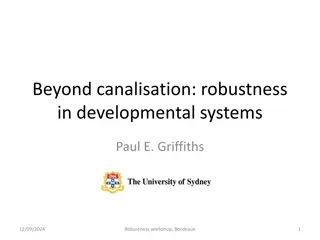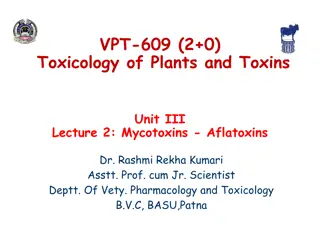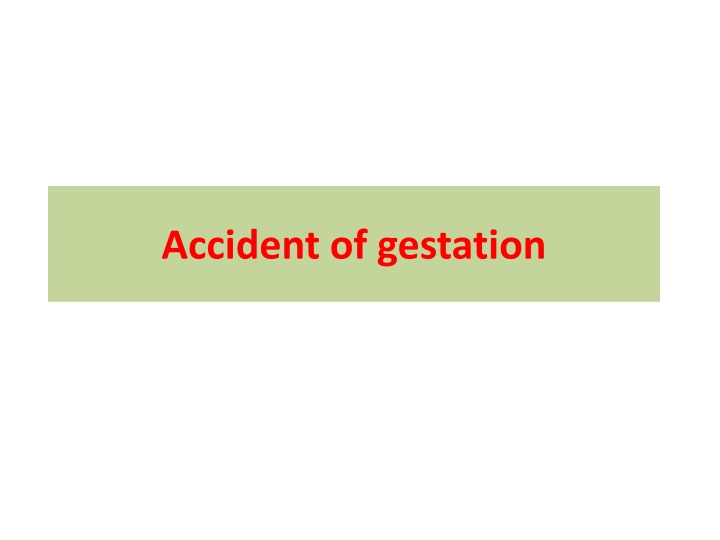
Developmental Anomalies and Teratogens
Developmental anomalies of the conceptus and the harmful effects of teratogens on organogenesis in the fetus are discussed. Genetic defects, viral diseases, and the role of hormones in conceptus development are explored, shedding light on potential risks and complications during gestation.
Download Presentation

Please find below an Image/Link to download the presentation.
The content on the website is provided AS IS for your information and personal use only. It may not be sold, licensed, or shared on other websites without obtaining consent from the author. If you encounter any issues during the download, it is possible that the publisher has removed the file from their server.
You are allowed to download the files provided on this website for personal or commercial use, subject to the condition that they are used lawfully. All files are the property of their respective owners.
The content on the website is provided AS IS for your information and personal use only. It may not be sold, licensed, or shared on other websites without obtaining consent from the author.
E N D
Presentation Transcript
Developmental Anomalies of Conceptus Embryopathy- Suffering of conceptus from various diseases. The harmful effect on developing conceptus occurs during 0- 14, 14-35 & fetal stage from 35 days onward Zona-pellucida effective barier to protect early embryo or up to 9 days post fertilization from viral infection Embryo- growth & differentiation of cells are maximum. Germs cells arranges into layer Organogenesis- start in orderly sequences under control of gene.
Cont. Genetic defect-Heredity or mutation teratogens including viruses may interfere the biochemical reaction in the developing fetus----------lead to an aberration in the development in the intrauterine life or some extraneous Placental Blastostatin A sustance from endometrial secretion of Pig inhibits the synthesis of DNA in 16 day old trophoblast and cause embryonic death
Viral Diseases The myxovirus, herpes virus, picorna virus and rubella infection -------------teratogenic in mammal In farm animals- viruses of BT in sheep, swine fever,IBR,BVD, Equine rhinopneumonitis, equine arteritis Viral infection ------changes in chromosome of fetus BVD hydrocephalus, impairment in immunological competence ---------------Occular defect, cerebellar dysplacia, BT in pregnant cows ---------------- abortion, still birth prognathia, hydroencephaly dummy calf syndrome etc.
Adverse effect of teratogens on organogenesis Improper differentiation of Palate Cerebellum Urogenital system Death of fetus followed resorption and mummification When aberration is of less severe Structural deformity in fetus lead to dystocia, still birth and birth of stunted offspring
Placental development fatal growth ; Nutrition Unequal placental contact with endometrium--- ----- un equal size of equine twins , Sow and bitch
Role of hormone on development of conceptus P4 & E2 in early pregnancy Placental weight- estrogens production Insulin & cortsone influence the metabolic activity Deffiency of Insulin and cortisone in early phase of fetal development --------adversely affect the growth and development of conceptus Conclusion common genital malformation are influenced by a variety of etiological factors and are primarily dependant on genetic make-up of fetus and the dam
Chromosomal abnormality Karyotype- Numerical and morphological feature of chromosomes Ovarian aplasia or dygenesis --- Turners syndrome (absence of sex chromosomes) eg Ovarian hypoplasia Extra Sex chromosome (XXY)-----Testicular aplasia & absence of secondary sexual character. Very rare in bull,ram, boar and dogs Chromosomal Translocation---------reduced fertility & embryonic death Irradiation of pregnant cows,ewes,sows and goat between 15-34 of pregnancy causes skeletal defects in their progenny.
Inherited defects a) Atresia ani b) Scrotal and umblical hernia c) C left palate d) Malformation of skeleton and internal organ e) Cryptorchidism f) Testicular hypoplasia g) Hermaphroditism h) Segmental uterine hypoplasia in pig
Cont Bull dog calve Mummification Congenital Dropsy in ayrshires Anchylosed or muscle contracture monsters Prolonged gestation Hydrocephalus in all breed Cryptorchidisim Ovarian and testicular hypoplasia Segmental aplasia of wolffian duct and Mularian duct called white heifer diseases Scrotal and inguinal hernia Sperm defect in Friesian
Common developmental abnormality in bovine Schistoma reflexus: Ruminant and Swine Visible sign of abnormality : Angulation of vertebral Column of fetus; Incomplete chest and abdominal cavity Cause: Genetic transmission from bull to offspring Persomus elumbis: Ruminant and Swine Visible signs of abnormality : Hypoplasia or aplasia of spinal chord of fetus in thoracic region ; loss of joint movement ; rigidity of posterior limb ; atrophy of musscles Double monster: Ruminant and Swine Visible sign of abnormality; Anterior duplication is very common Rectovaginal constriction
Abortion and causes of infertility in farm animals Abortion: expulsion of living fetus prior to attainment of viable age/dead fetus of recognisable size at any stage of gestation from the gravid uterus of the dam Premature birth of immature viable fetuses is called premature birth Dead fetus expelled at term are called still birth
Causes Non- Infectious Infectious Physical Genetic Environmental Bacterial Mineral and Vitamin difficiency Mycotic toxic Protozoal Hormonal Viral
Infectious Bacterial-Brucellla; Leptospira; mycobacterium; V.fetus; Streptococcus; Diplococcus; E coli; Alkaligenes; Pseudomonus; C. Pyogenes Viral- IBR; IVP; Epizootic bovine abotion (Chlamydia) Mycotic- Aspergillus; yeast Protozoa- Trichomonus fetus; Toxoplasmosis; Trypnosomiasis; Anaplasmosis and Babesia
Non-Infectious Nutritional- Starvations; malnutrition; Vit A difficiency; Iodine deficiency Physical causes-Accidental insemination in preg uterus; rupture of amniotic vessicles; Trauma to embryo; removal of CL and torsion Genetic causes
Brucellosis in cattle The diseases brucellosis in cattle also called Contagious or infectious abortion or Bang disease Etilogy- Br. Abortus; The organisms grow intracellular B. abortus is mainly infective for cattle. The other animal also get infected are Sheep; goat; dog; Swine and horse Site Founded in chorion of placenta in the pregnant animal and produces severe pathologic changes like necrosis and edema and also in the digestive tract and lungs of fetus It remains as persistent infections in udder,suprsmammary gland, retropharyngeal, limph nodes of adult cattle Joint and Bursa In testes, Epididymis,V. differenia, and seminal Vesicle
Transmission By purchase of infected cow Infected material from one farm to other Contact of infected animal Ingestation of the feeds and water contaminated by genital discharge of infected animal AI with infected semen
Sign and Symptoms of diseases Abortion usually takes place from 6th to 9th month of pregnancy Udder development and oedema of vulvae Fetal membrane is found to be edematus, haemorrhagic, leathery and even necrotic RFM and metritis are common symptoms

